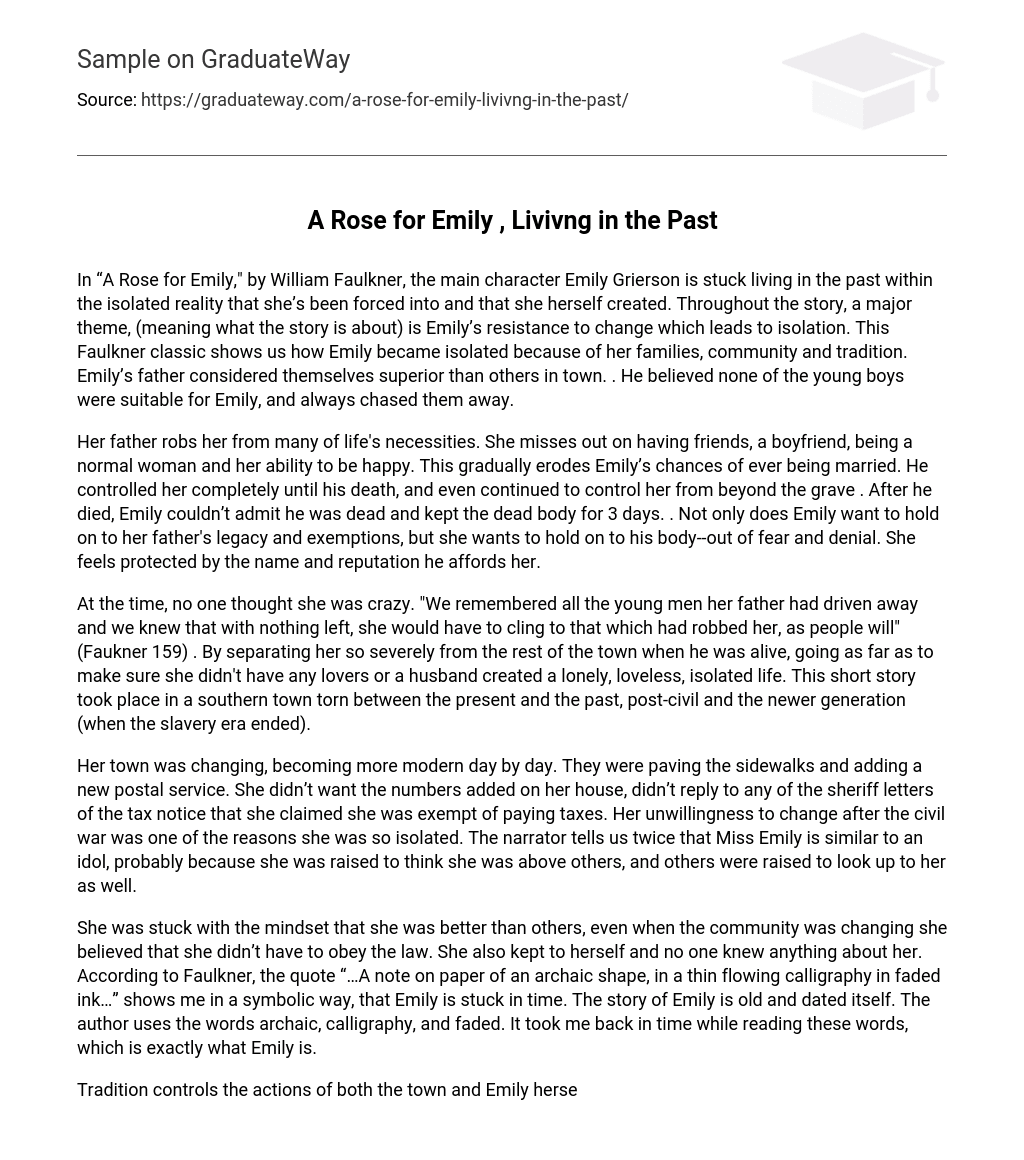In William Faulkner’s “A Rose for Emily,” the protagonist Emily Grierson finds herself trapped in a stagnant existence, living in the past and the isolated reality she has created for herself. The story revolves around Emily’s refusal to accept change, resulting in her becoming isolated from her family, community, and the traditions that bind them together. Emily’s father held a belief of superiority over the townspeople and drove away any potential suitors he deemed unsuitable for her.
Her father depriv es her of many life necessities, resulting in her lack of friendships, romantic relationships, normalcy, and happiness. This deprivation also diminishes Emily’s chances of finding a spouse. He exerted complete control over her until his death, and even beyond the grave, he continued to exert control. After his demise, Emily couldn’t acknowledge his passing and kept the lifeless body for three days. Not only does she desire to maintain her father’s influence and privileges, but she also clings to his remains out of fear and refusal to accept reality. The name and reputation he bestows upon her provide a sense of security.
According to William Faulkner (159), she was not considered insane at that time. She had no choice but to hold on to what had taken everything away from her, as people tend to do. Everyone remembered how her father had driven away all the young men, and it was evident that she would cling to the only thing that remained. Her father deliberately isolated her from the rest of the town during his lifetime, ensuring that she stayed unmarried and without any lovers. As a result, she lived a solitary and loveless life, completely cut off from everyone else. This short story is set in a southern town torn between the past and present, navigating through the post-Civil War era and witnessing the emergence of a newer generation after slavery was abolished.
The town was undergoing rapid modernization, with the addition of paved sidewalks and a new postal service. However, the protagonist resisted these changes, refusing to have numbers added to her house and ignoring letters from the sheriff regarding tax payment, as she believed herself exempt. Her refusal to adapt after the civil war led to her isolation. The narrator describes Miss Emily as resembling an idol, suggesting that she was brought up to consider herself superior and others were raised to admire her.
Despite the changing community, she held on to the belief that she was superior to others and exempt from the law. She maintained a private life, keeping her true self hidden. According to Faulkner, the quote “…A note on paper of an archaic shape, in a thin flowing calligraphy in faded ink…” symbolizes Emily’s stagnation in time. Like the story of Emily itself, the author’s use of the words archaic, calligraphy, and faded transported me back in time.
Both the Southern community and Emily’s life in “A Rose for Emily” demonstrate the importance of tradition. In the midst of the Civil War, preserving traditions, including slavery, was crucial to the lifestyle of Southerners. Emily’s refusal to pay her taxes can be attributed to her aristocratic upbringing; her father, being part of the upper class, was exempt from taxation. However, as slavery was abolished and the South faced decline, traditional families like Emily’s suffered a loss in both social status and financial stability. The arrival of carpetbaggers further exacerbated this situation, leaving native Southerners feeling unsettled and displaced.
Due to their limited capabilities, the townspeople clung to their established behavioral norms. Faulkner’s statement that “of course a Grierson would not think seriously of a northerner, a day laborer” exemplifies the town’s enduring traditional practices. They felt disconcerted that Emily was involved with someone below her social status and believed it betrayed the entire community. These behavioral expectations also influenced Emily’s mindset. It was customary for southern women to marry. Emily could have followed this path and been socially acceptable. However, when she encountered Homer Barron, the love of her life, everything changed.
Homer’s refusal to settle down and Emily’s fear of abandonment shape their actions and choices. Emily’s father’s death is a pivotal event that shapes her identity and influences her decision to kill Barron. She poisons Homer in order to keep him by her side indefinitely, even sleeping with his body at night. Emily’s adherence to tradition prevents her from moving forward, leading her to remain fixated on the past. In William Faulkner’s “A Rose for Emily,” Emily Grierson serves as a tragic example of the consequences of holding onto the past, resulting in isolation. The only rose she ever received was placed on her casket, symbolizing her unfortunate fate.





